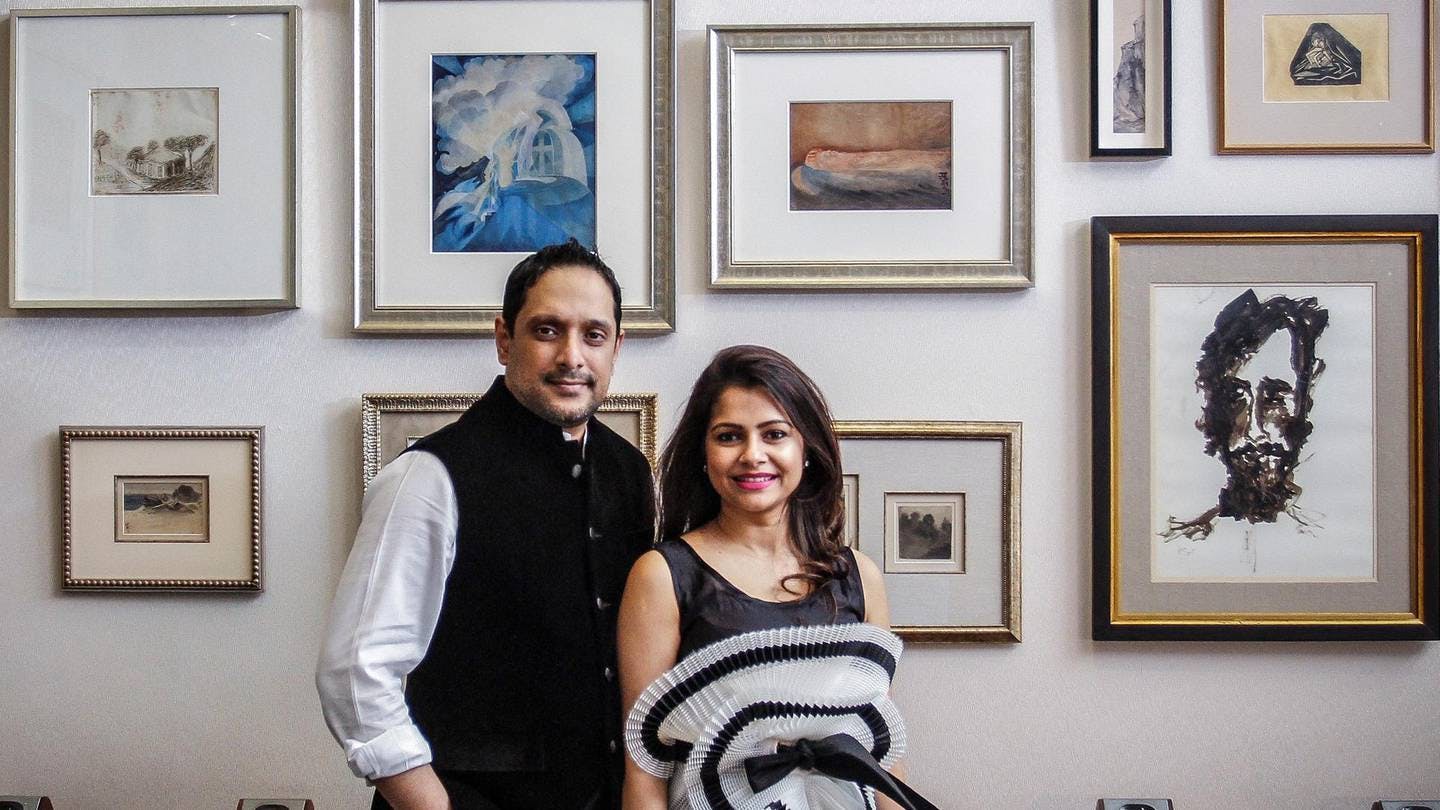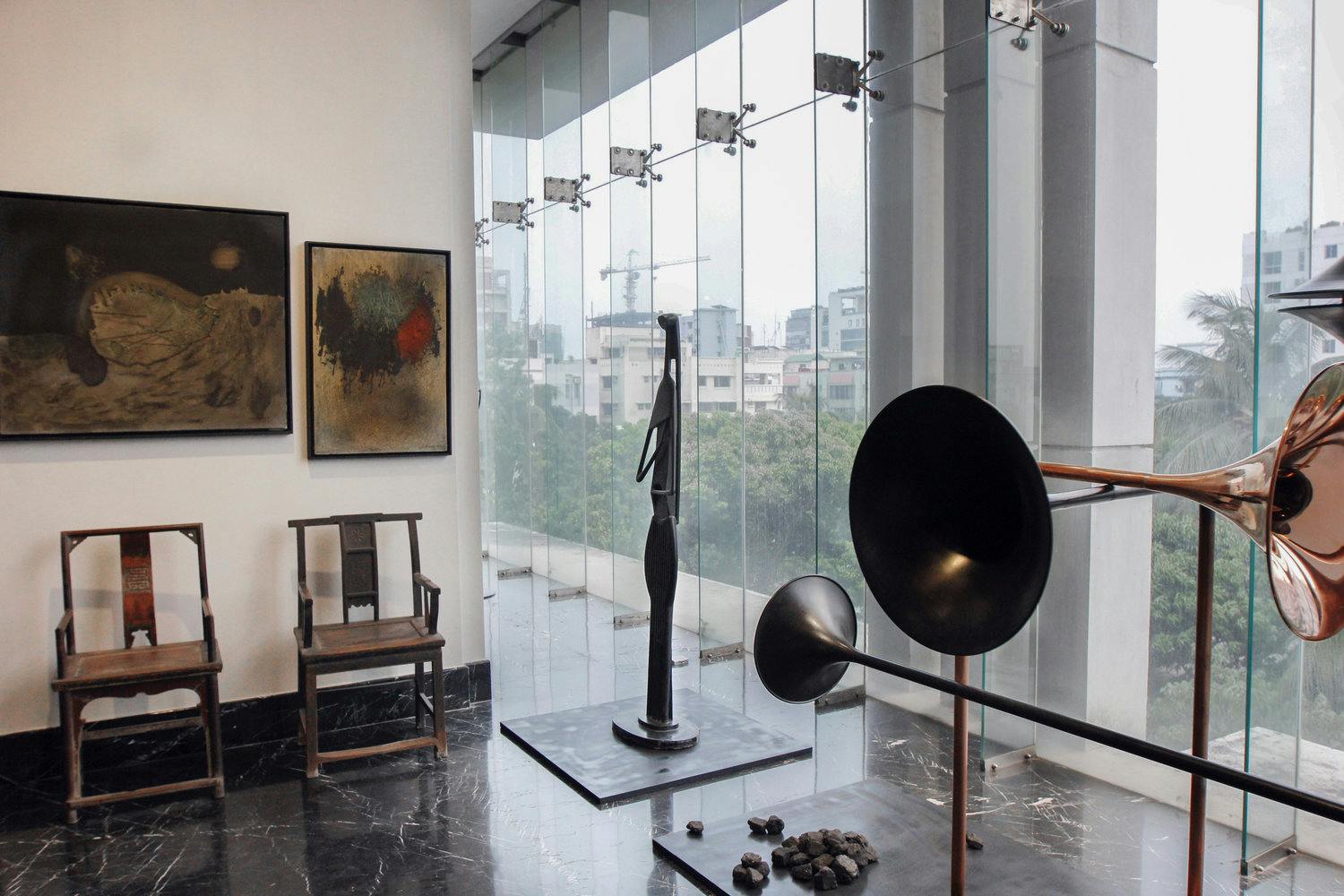Nadia and Rajeeb Samdani: art collectors and advocates of Bangladeshi art

Bangladeshi contemporary art collectors Nadia and Rajeeb Samdani are committed to supporting the work of South Asian artists and the emerging art scene of their country. Following this intention, in 2011, the couple started the Samdani Art Foundation and are also the masterminds behind the Dhaka Art Summit, a biennial event that has increased the international exposure of Bangladeshi arts. In this post, we look into the collecting journey of this power couple who nowadays are planning to open a large-scale arts center, The Srihatta Samdani Art Center and Sculpture Park, in Bangladesh.
Who are Nadia and Rajeeb Samdani?
Based in Dhaka, Bangladesh, Nadia and Rajeeb share a passion for art. Rajeeb is the Chairman of Gulf International Finance Limited, UAE, and Managing Director of Golden Harvest Group, one of the leading diversified conglomerates in Bangladesh, which has interests in banking, property, agriculture, food processing, and more. Next to his cultural philanthropy, he is the Secretary General of the Bangladesh Human Rights Foundation, Founder of the Taher Ahmed Chowdhury Charitable Hospital. in Sylhet, and the Alvina Samdani Trust. Nadia grew up in the UK and moved to Dhaka in the early 1990s. She studied economics and management at Independent University in Bangladesh and comes from a family of art collectors that instilled in her a love for art. She has written about collecting for Art Asia Pacific and Live Mint and is often a guest speaker at art fairs and institutions including the Royal Ontario Museum, Art Basel, Frieze, and Harvard University.
How the Samdani collection came to be
Stemming from her art-filled upbringing Nadia started collecting at age 22 when she bought a watercolor by S.M. Sultan, her country’s pioneering avant-garde artist, featuring a peasant life scene. On his side, Rajeeb’s first purchase was a painting by Zainul Abedin, considered by many as a foundational figure in Modern Bangladeshi art, but he did not label himself a collector until he got together with Nadia. “It all started through a passion for collecting art for the love of art. Thank god we have the same taste and the same passion,” Nadia said in an interview.
For some time, the couple continued collecting early 20th-century art, including works ranging from Indian modernists to Picasso and Dalí but soon decided to focus on contemporary art. “I can’t tell you when exactly I found myself looking at contemporary art, but I know it was a natural reaction to better connect with what artists are saying today,” Nadia shared in the couple’s interview with Robb Report in 2020. This connection was obtained through the frequent travels the duo made to the most important art galleries, art fairs, and biennials. They also made a lot of studio visits and started to get to know the artists personally.
While over the years the couple have been passionate supporters of Bangladeshi, Pakistani and Indian artists, the collectors have also bought works by international contemporary artists, mainly from Asia and Europe, that are significant to them. Hence, their collection has an eclectic focus and is divided between their collection of South Asian art and an international collection that reflects their journey as art collectors. “Some collectors are focused on South Asian art, or they only collect photography,” said Rajeeb to Tatler Asia in this interview. Adding, “We don’t want to bind ourselves with these things. Whether we’re focused or whether we’re not—who cares? It’s not a competition. It’s what we enjoy.”
As stated on the couple’s foundation website, nowadays The Samdani Art Foundation Collection has over 2,000 works ranging from sound and video pieces to drawings and prints. Highlights of the South Asian collection include works by Anish Kapoor, Gaganendranath Tagore, Abanindranath Tagore, Rabindranath Tagore, Huma Bhabha, Naeem Mohaiemen, Rana Begum, Raqs Media Collective, Shilpa Gupta, Shahzia Sikander, Novera Ahmed, and Zarina Hashimi. Next to this, among the international holdings, which intend to bring the art that touches and challenges the couple on their travels to Bangladeshi audiences, are works by Lynda Benglis, Chris Ofili, Alighiero Boetti, Paul Klee, Ettore Spalletti, Cindy Sherman, Marina Abramovic, Ai Weiwei, Pawel Althamer, Mona Hatoum, Philippe Parreno, Dominique Gonzalez-Foerster, Cardiff and Miller, and Anthony McCall. There are also some works by artists of the African diaspora, including the one-time Young British Artist Chris Ofili and Kenyan-born artist Michael Armitage. At the same time, the couple owns pieces by emerging stars like US artist Avery Singer.
Gradually, the Samdanis turned into well-respected art collectors. As proof of this, they have received diverse distinctions for their collecting and philanthropic practices. For example, in 2017, Rajeeb and Nadia were the first South Asian arts patrons to receive the Montblanc de la Culture Arts Patronage Award and, in 2022, Nadia was appointed Member of the Order of the British Empire (MBE) for her services to global art philanthropy and supporting the arts in South Asia and the UK. The couple has also repeatedly appeared on ARTnews’s Top 200 Collectors list and Art Review’s Power 100 list.
As part of the collectors’ mission to bring international attention to South Asian artists they also have an active role in the museum world. Most notably, Rajeeb and Nadia are founding members of the South Asian Acquisition Committee at the Tate museum network in England, and are also among the founding members of The Harvard University Lakshmi Mittal South Asia Institute’s Arts Advisory Council.
The collection whereabouts

A portion of the couple’s collection is currently based at the Samdanis family's six-stories residence in the upscale neighborhood of Gulshan, Dhaka which, as their foundation’s website states, can be visited by appointment. The couple decided to name their house Golpo, a Bengali word for “story” or “fairy tale,” given they believe their residence tells a story through its art and architecture. Remarkably, the large-scale compound, completed in 2012, was specifically designed to fit the couple’s collection in every room. “We’ve acquired the art and then built the right space for it, not vice versa,” Nadia said to Robb Report. The resulting project is a home that feels very much like a museum and whose walls have a new display every 18 months or so. “It takes almost three months to figure out, looking through the archive and deciding where to place it,” Nadia stated. On occasion, they even build or tear down walls to accommodate the pieces they want to showcase.
Next to being displayed in their home, works from the collection are regularly lent to institutions and festivals around the globe. For instance, they have been lent pieces to the Met, in New York; the Museum of Modern Art, in Warsaw; and Documenta 14, in Kassel and Athens.
Supporting South Asian arts: The Samdani Art Foundation and the Dhaka Art Summit
In 2011 the collector couple founded the Samdani Art Foundation which “seeks to expand the audience engaging with contemporary art across Bangladesh and increase international exposure for the country’s artists and architects.” At the same time, it intends to make up for the absence of a dedicated modern art museum or art market in their birth country. With these ideas in mind, in 2012, the Samdanis took one step further and orchestrated the first edition of the Dhaka Art Summit (DAS). This week-long non-commercial event includes a series of lectures, talks, social events, and art exhibitions. “We wanted to put our country on the map,” Rajeeb declared to Tatler Asia. The summit started on a small scale but has increased its popularity with every edition. To get a glimpse of its fastly-growing attendance, in 2012 it received only 50 international visitors and in 2020 it was attended by 400,000 people including curators, artists, and other art professionals from around the globe.
As proof of the importance of the event, which also entails the participation of the Bangladeshi government, some exhibitions originally curated for the summit have traveled to different venues across the globe including Para Site, in Hong Kong; the Gwangju Biennale, in South Korea; the Singapore Biennale; the Berlin Biennale, and more. Each edition of the Summit also includes the Samdani Art Award, which is open to Bangladeshi artists between the ages of 20 and 40 years. Around 10 to 20 shortlisted artists make it to a show and are judged by a jury of international art experts. The winner gets a three-month art residency at the Delfina Foundation, in London.
DAS, as it is known, has also partnered with reputed institutions, such as Cornell University and Asia Art Archive, to launch the project Connecting Modern Art Histories in and across Africa, South and Southeast Asia, which engages scholars from Cape Town to Nepal. Meanwhile, the foundation has collaborated with other international institutions on many research and art exhibition projects staged in Dubai and elsewhere. As they shared in an interview, this all forms part of the couple’s intention “to help a new generation of art historians consider Bangladesh comparatively to other contexts in the “Global South” – breaking the need to justify our art history by contextualizing it within western paradigms.”
Here, it must be said that a key figure for the many projects the Samdanis put together is American curator Diana Campbell Betancourt, who advises them on their collection and DAS in her dual role as the Founding Artistic Director of the Samdani Art Foundation and Chief Curator of DAS. Next to this, she often curates art exhibitions featuring the works from the collection and helps the couple rotate the display of artworks at Golpo, as well as in the office and factory spaces of Golden Harvest. “They are the dream art patrons for a curator to work with, because they love art and artists, but they’re not trying to be the curators,” she explained to Robb Report.
The next step: The Srihatta Samdani Art Center and Sculpture Park

The Samdanis have a new project on the works, a brand-new art complex with a 465sqm gallery, a 930sqm artist and writer residency facilities for up to 10 artists, and a 40-hectare sculpture park. The massive project, which contemplates inviting artists to create site-specific commissions and connect with the local culture, is currently being built in the northeastern city of Sylhet, where both Samdanis grew up. “Like the Dhaka Art Summit, Srihatta was born from a long-time dream to innovate a new destination for South Asia in Bangladesh, one that revolves around art,” Nadia has said of the project to Art News. Adding, “Rajeeb and I are now realizing our dream—in the district where our families come from—to build a permanent home for the Samdani Art Foundation’s activities and a dynamic art center international in approach.”
Designed by Bangladeshi architect Kashef Mahboob Chowdhury, the art center intends “to open up new possibilities for art and community engagement in rural Bangladesh and raise standards for the public accessibility of institutions in South Asia.” According to the foundation’s website, the first project realized on this site is Rokeya, an interactive sculpture created in collaboration with the local community by leading Polish artist Paweł Althamer in early 2017.
The opening date for this arts center, originally scheduled for 2021, has not been revealed. Hopefully, it won’t be much longer. In the meantime, we can continue to follow the mission-driven work of this collector couple that are advocates of the rich past and contemporary culture of their birth country.

